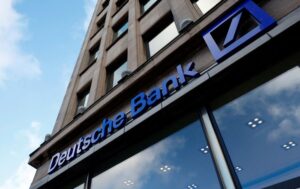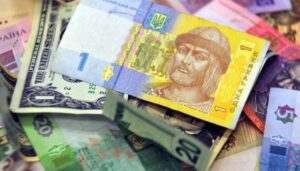
Analysts at Deutsche Bank have also improved their gold price forecasts for 2025 and 2026 amid geopolitical and foreign trade uncertainty, which is contributing to increased demand for the protective asset. Experts expect gold to cost an average of $3140 per troy ounce this year and $3700 per ounce in 2026. The previous forecast was $2725 and $2900 per ounce, respectively. At the end of 2025, experts estimate that gold will cost $3350 per ounce.
Deutsche Bank’s forecast for 2026 is the most optimistic among the world’s leading banks.
Quotes of June gold futures on the Comex exchange are growing by 1.6% – to $3022 per ounce. On the eve of the precious metal price fell below the psychologically important mark of $3000 per ounce.
One of the factors supporting gold is the active demand for precious metals from the central banks of the world. According to Deutsche Bank estimates, central banks now account for about 24% of global demand for gold against 10% in 2022.
Last week, HSBC analysts improved their gold price forecast for 2025 to $3015 per ounce, but in 2026 they expect quotes to fall to $2915 per ounce.

Issue No. 1 for November 2024
The global currency market was shaken by Donald Trump’s victory in the US presidential election, which created a wave of expectations and uncertainty.
The real balance of power will become clearer only after the first practical steps of the new administration, which will indicate the key vectors of the US economy, determine their global influence on allied countries and blocs, and show the policy of influencing the US global competitors outside the Western world.
Currently, there are no fundamental economic reasons for significant exchange rate corrections, and what we are seeing in the global context in the currency and cryptoasset markets is more like “fussing on deck waiting for the weather to change,” although there is no clear forecast or signs of change, everything is based on more or less probable assumptions, expectations, and faith.
Now is not the best time to formulate medium-term currency strategies. However, if you have developed speculative skills and a taste for risk, you can make money from speculation in a period of high uncertainty in the currency markets.
Meanwhile, Ukraine is experiencing record demand for foreign currency, which is also driven more by global processes and the far from optimistic expectations of households and businesses. The real need for foreign currency can only exist and grow in the shadow sector, where some business operations are moved in the face of economic and tax uncertainty, infrastructure and economic risks. However, the real needs for foreign currency for import-oriented sectors are within normal limits.
Thus, Ukraine’s FX market remains under pressure from psychological factors, although fundamental macroeconomic indicators do not yet provide grounds for strong devaluation pressure and abrupt exchange rate movements. The only certainty is that we will see further gradual devaluation of the hryvnia, at least in the current security and economic environment.
The combination of these factors is pushing citizens to transfer their savings into foreign currency instruments, and many are focused on cryptocurrencies.
Dollar exchange rate forecast
As we predicted earlier, the US dollar exchange rate remained relatively stable in November with minor fluctuations. The average buying rate fluctuated between 41.20 and 41.35 UAH/$, and the selling rate between 41.65 and 41.75 UAH/$. The official NBU exchange rate remained at UAH 41.20-41.35/$ amid no significant interventions by the regulator.
The spread between the bid and ask rates remained stable at UAH 0.40-0.50/$, reflecting the fragile economic equilibrium and the balance between supply and demand.
Outlook:
Euro exchange rate forecast
As expected, the euro continues to show a steady downward trend after reaching peak levels of 46.18-45.6 UAH/€ in October. In the second decade of November, the average euro exchange rate corrected from 45.25-44.67 UAH/€ to 44.65-44.1 UAH/€.
The downward spread between buying and selling euros remained relatively flat at UAH 0.55-0.65/€, indicating that FX market operators are trying to keep an additional premium on the increased demand for the euro, while the purchase of euros from households and businesses is closer to the official NBU rate, the unwillingness of FX market operators to take on currency risk in the event of a reverse “rebound” in the euro, which may be due to new signals from key players in the global economic system.
Forecast:
Future factors influencing the Ukrainian currency market
The key ones still dominate:
Negative:
Positives:
Recommendations on currency transactions
This material was prepared by the company’s analysts and reflects their expert, analytical professional judgment. The information presented in this review is for informational purposes only and cannot be considered as a recommendation for action.
The Company and its analysts make no representations and assume no liability for any consequences arising from the use of this information. All information is provided “as is” without any additional guarantees of completeness, obligations of timeliness or updates or additions.
Users of this material should make their own risk assessments and informed decisions based on their own assessment and analysis of the situation from various available sources that they consider to be sufficiently qualified. We recommend that you consult an independent financial advisor before making any investment decisions.
REFERENCE
KIT Group is an international multi-service product FinTech company that has been successfully operating in the non-banking financial services market for 16 years. One of the company’s flagship activities is currency exchange. CIT Group is one of the largest operators in this segment of the Ukrainian financial market, is among the largest taxpayers, and is one of the industry leaders in terms of asset growth and equity.
More than 90 branches in 16 major cities of Ukraine are located in convenient locations for customers and have modern equipment for the convenience, security and confidentiality of each transaction.
The company’s activities comply with the regulatory requirements of the NBU. CIT Group adheres to EU standards, having a branch in Poland and planning cross-border expansion to European countries.

Domestic prices for Ukrainian sugar continue to fall due to trade restrictions imposed by the European Union, and wholesale prices from factories may drop to 18-19 UAH/kg, according to the analytical cooperative “Pusk”, created within the framework of the All-Ukrainian Agrarian Council (AAC).
“Ukrainian sugar remains mostly on the domestic market due to limited exports. Attempts to supply products to Turkey, Macedonia and other countries have not yet allowed to significantly unload stocks. Due to trade restrictions with the EU, which will last until 2025, Ukraine is facing difficulties in exporting sugar,” the analysts explained and added that this trend is likely to continue in the coming months.
According to experts, some factories in Ukraine have already started to reduce prices from the previous 21.50-22 UAH/kg to 21 UAH/kg. They expect that in September-October, prices may fall to 18-19 UAH/kg due to the oversaturation of the domestic market.
At the same time, the global sugar market shows a significant increase in prices due to a number of factors.
“Among the key reasons is a significant drought in Brazil, which has seriously affected sugar cane yields. The situation was further aggravated by large-scale fires that damaged 5 to 8% of the acreage. This has led to a significant increase in the cost of sugar on world markets,” Pusk stated.

Prices for Ukrainian wheat, corn rape and sunflower remained unchanged over the past week of January 5-12, while soybean prices are rising towards Poland and Italy, where premiums for it may reach EUR20/tonne.
As reported by brokerage company Spike Brokers (Kiev) in Telegram-channel on Thursday, last week, it concluded deals on DAP terms (seller bears the risk for the cargo before delivery to the destination) for the delivery of wheat to Ukrainian ports in January-February for 8 thousand UAH / ton. UAH/ton, corn to Ukrainian ports and the Slovakian border for $208/ton and $230/ton, soybeans (GMO) to Poland for $528/ton and sunflower to Romania for $540/ton.
According to the brokerage, corn prices in Ukraine remain unchanged from last week. The latest indications of buyers for last week: DAP Poland (border) $210-220/ton, DAP Hungary – $220-230/ton, DAP Romania (border) – EUR200-210/ton.
In turn, a stable supply of wheat in the world has not allowed prices to rise last week, the Ukrainian wheat is trading at stable levels of $205-210 for feed quality and $220-225 for food quality in the direction of DAP ports Odessa, Pivdenniy and Chornomorsk. Latest buyer indications: DAP Poland (border) – $220-240/ton, DAP Hungary (border) – EUR200-220/ton, DAP Ukraine (ports) – $205-225.
According to the trader, the purchasing prices for sunflower remain at the level of the previous week, although its supply began to increase in the direction of Bulgaria, Romania and Hungary. In addition, the premium for high oleic sunflower remained at $35/ton. The latest indications of sunflower seed buyers are DAP Bulgaria (center) – $540-555/ton, DAP Romania (center) – $530-540/ton, DAP Hungary (center) – $530-555/ton.
In addition, during the week prices for rapeseed from Ukraine did not change due to the oversaturation of the European market. Latest buyer indications: DAP Germany (east) – EUR530-545/ton, DAP Poland (west) – EUR540-560/ton, DAP Slovakia (west) – EUR540-550/ton.
“There is a recovery in demand from the Italian and Polish soybean markets. The premium for NOT GMO soybeans is up to EUR20/ton in the direction of Italy. Demand for GMO soybeans at Ukrainian ports remains at $460-470 DAP,” the brokerage specified.
Latest indications of soybean buyers for the week: DAP Ukraine – $460-470, NOT GMO DAP Italy (south) – EUR550-560, GMO DAP Italy (south) – EUR535-540.

Oil prices could soar into the stratosphere and reach $380 per barrel in a worst-case scenario in which Russia cuts fuel supplies in response to Western sanctions, J.P. analysts predict. Morgan Chase & Co.
The Russian Federation can afford to cut production by 5 million barrels per day without causing excessive harm to the economy, Bloomberg quoted bank analysts as saying. Moscow may take such a measure due to various possible measures by the West, including imposing a ceiling on the price buyers pay for Russian oil.
At the same time, the consequences of such actions for the rest of the world will be catastrophic. A 3 million bpd production cut would push Brent oil prices up to $190 per barrel, while in a worst-case scenario, if production falls by 5 million bpd, prices will soar to $380 per barrel, experts say.
“The most obvious and likely risk associated with imposing a price cap is that Russia may decide not to participate in this scheme and instead retaliate by cutting exports,” the analysts wrote. “It is likely that the government may retaliate by cutting production to harm the West. The lack of supply in the world oil market is playing into the hands of Russia.”
September futures for Brent crude on the London ICE Futures exchange by 10:23 Moscow time are trading at around $111.8 per barrel, futures for WTI oil for August on the New York Mercantile Exchange (NYMEX) by this time are about $108.6 per barrel. barrel.

Analysts at Bank of America (BofA) Global Research do not expect further nominal strengthening of the hryvnia, according to a June 14 BofA study.
The bank said that it is still constructive in relation to the International Monetary Fund (IMF), but the bank does not expect further nominal strengthening of the hryvnia, especially given the seasonality of the exchange rate in the third quarter, BofA said.